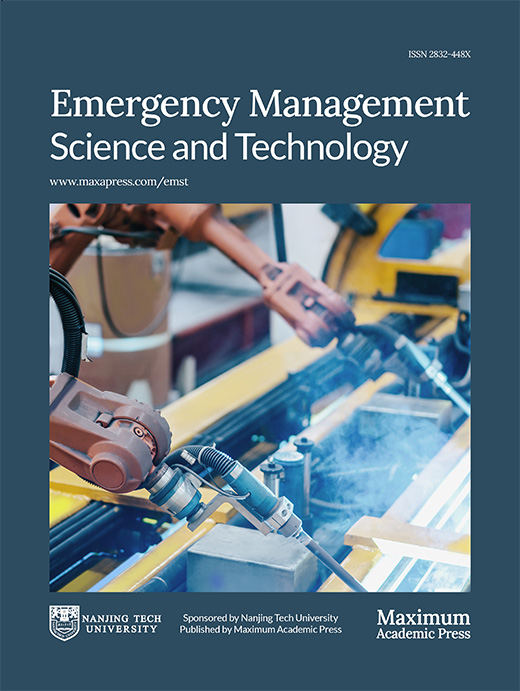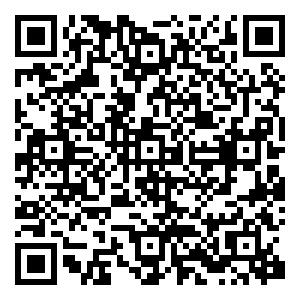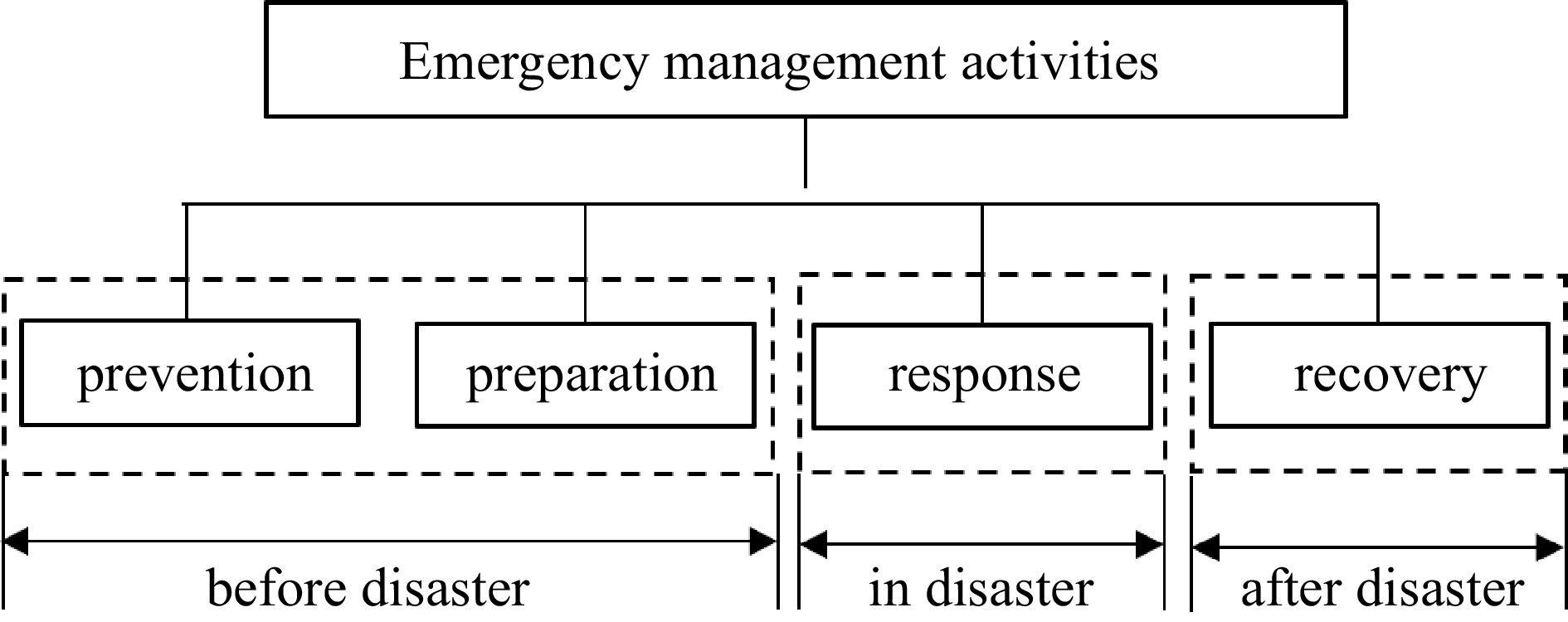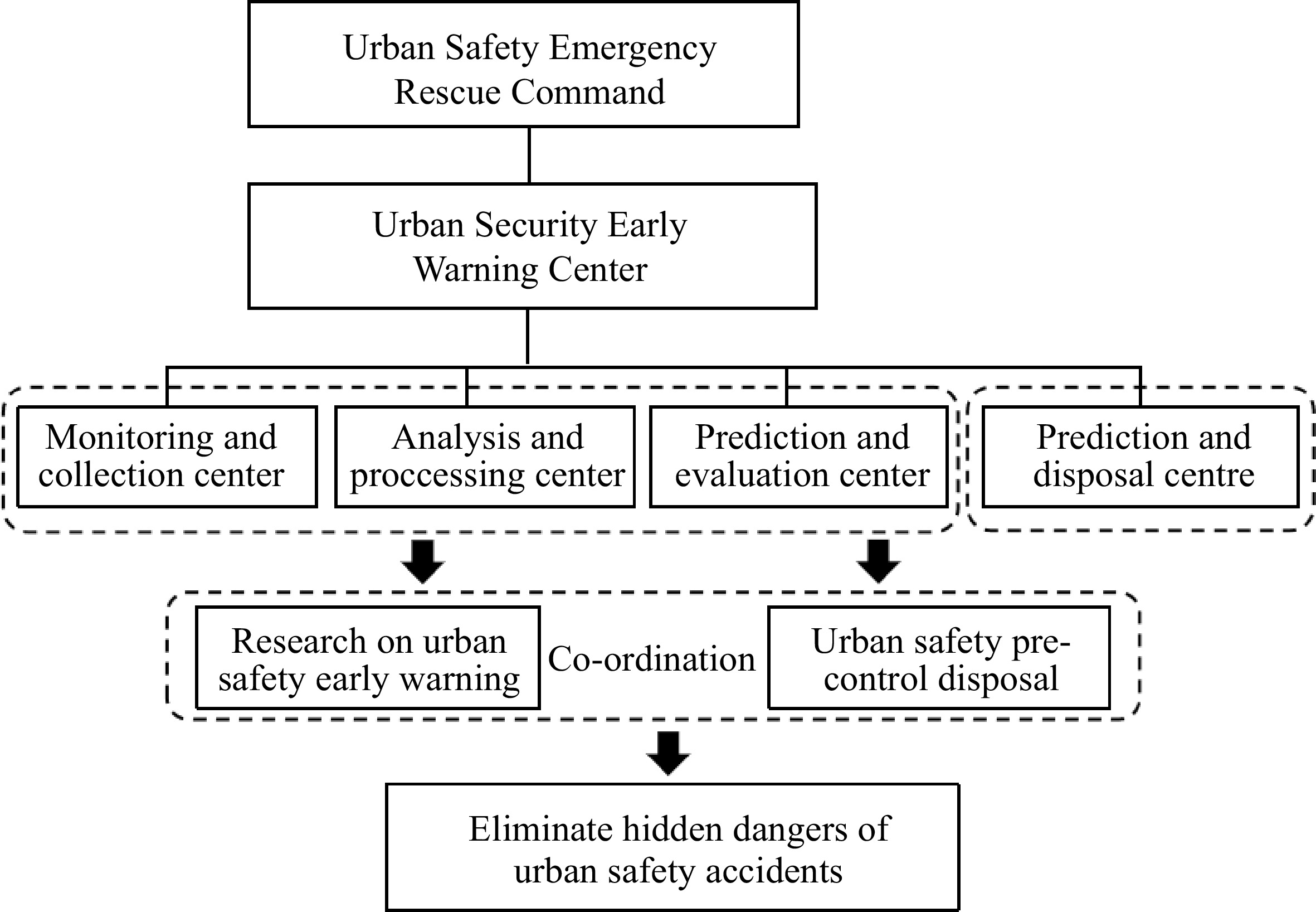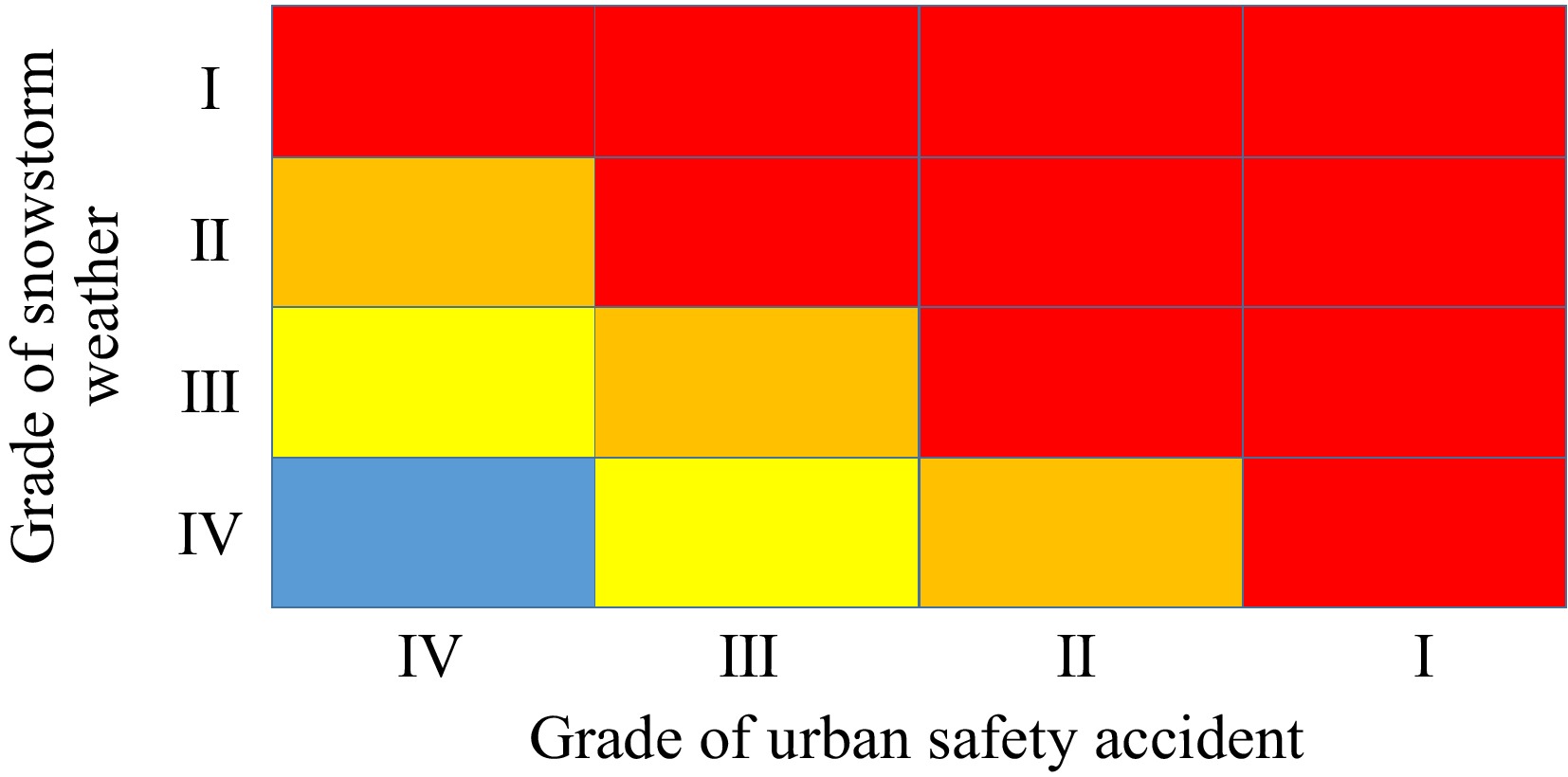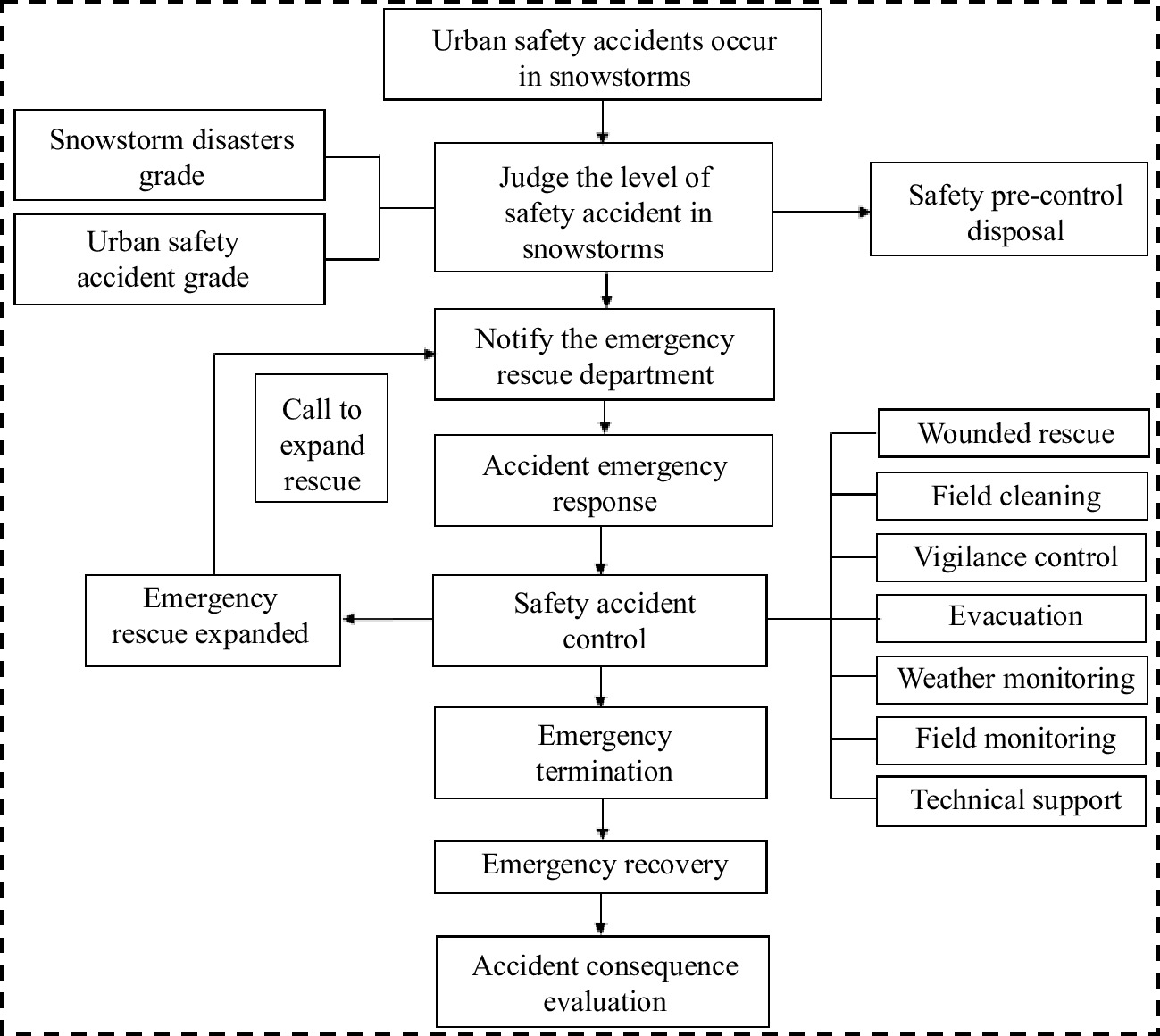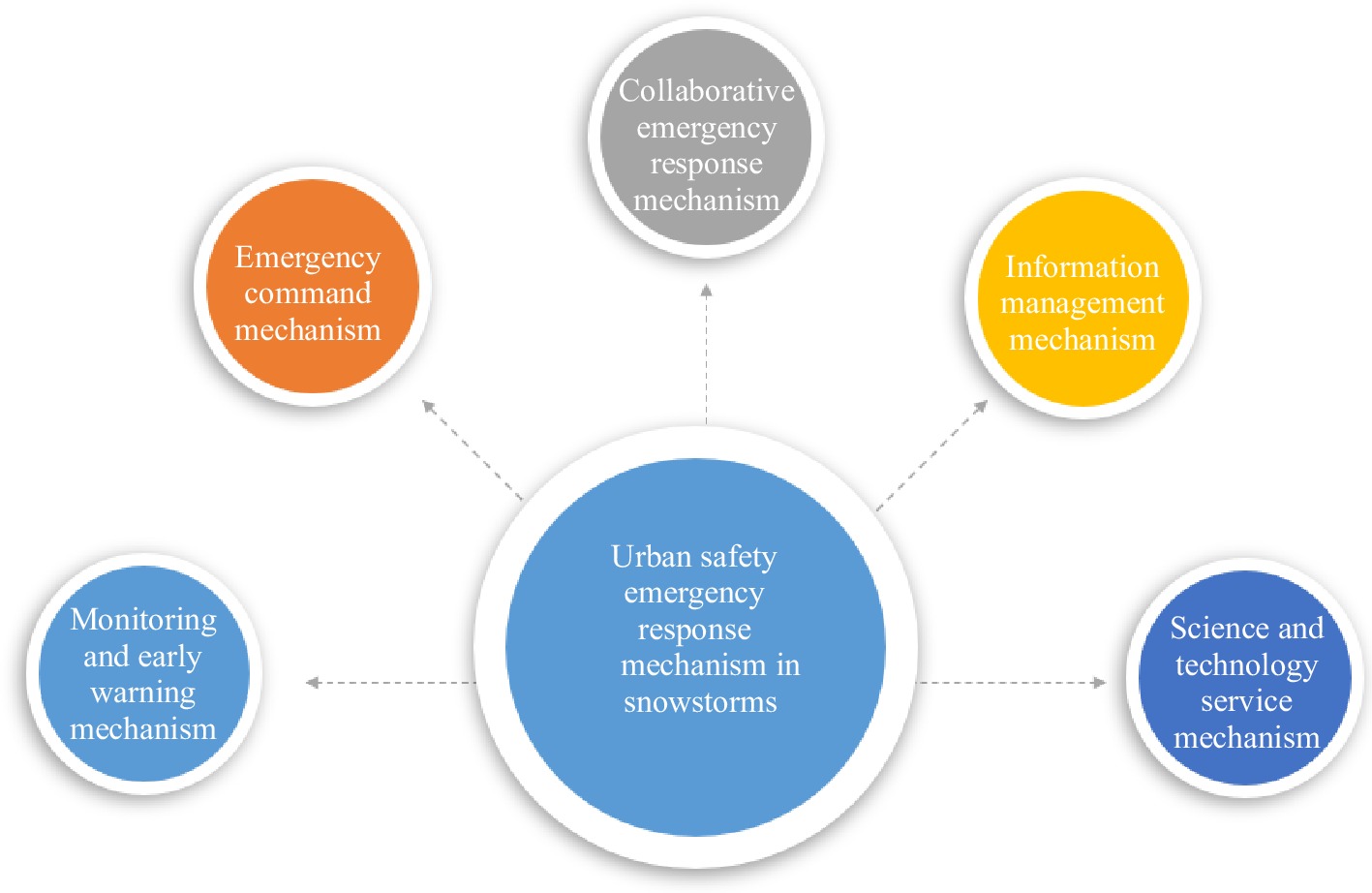-
With the rapid development of science and technology, society has entered the stage of rapid urbanization[1]. Urban safety is a key factor affecting the sustainable development of modern cities[2]. However, urban security risks are constantly increasing in the process of high-speed urbanization[3]. Compared with industrial production safety, urban safety involves all aspects of our life, such as urban major hazard sources, urban important institutions, urban important public places, urban public infrastructure and so on[4]. Once the scope of disasters expands, urban safety accidents will become a factor inducing social instability, seriously hindering the sustainable development of society and the progress of human civilization[5]. Extreme weather is one of the main threats to urban security and it has the characteristics of multi-agent, multi-factor, multi-scale and variability[6, 7]. For example, urban safety accidents such as fires and explosions may cause business shutdowns, traffic jams, and social panic. Snowstorms are a common extreme weather in the north and it is also frequent in southern cities[8, 9]. In addition to causing blizzard freezing meteorological disasters, snowstorms may also cause a series of secondary and derivative disasters, such as traffic accidents, geological disaster accidents, occupational hazard accidents, industrial accidents and mass public accidents[10, 11]. Once the two situations occur at the same time, the scope of disaster impact will inevitably be further expanded due to the coupling effect and the development of emergency rescue operations will be greatly affected.
Based on the above reasons, higher requirements have been proposed for the construction of emergency response capability of urban security systems. At present, the means and methods of dealing with urban safety accidents under snowstorm conditions are relatively simple and general[12]. The coupling effect of disaster accidents and urban safety accidents caused by snowstorms and the differences between the northern and southern regions have not been considered[13]. The emergency plans in the emergency system are not well connected and coordinated. Therefore, the construction of the urban safety early warning system, emergency response and guarantee mechanism under snowstorms are necessary.
-
The urban safety emergency response mechanism is based on the safety laws and operates through the cooperation of safety emergency management systems. In developed western regions, most modern cities have established urban safety emergency response systems, especially in response to urban safety accidents in extreme weather. In the event of urban safety accidents, the emergency response system can quickly offer emergency response to reduce property losses and casualties. The federal emergency management agency (FEMA) is the first emergency department in the United States to respond quickly to urban safety risks by dividing emergency zones and establishing offices. As shown in Fig. 1, the emergency management includes four stages: prevention, preparation, response and recovery. Japan has set up a central disaster prevention conference committee. The responsibility is to dispatch between central government departments, central government agencies, local governments and local public agencies. Some countries in northern Europe have rich experience in emergency management under snowstorms and developed a series of emergency systems to reduce disaster losses.
The urbanization rate of China is slower than other western countries, so is urban safety construction. However, since 20023, China has set up a series of major projects to make up for the lack of public emergency response mechanism construction. Especially, the general office of the state council also set up a special research group to carry out the preparation of public emergency plans. By 2006, China issued the national emergency plan for public emergencies, connecting the provincial emergency plan for public emergencies of provinces. Autonomous regions and municipalities directly forming a horizontal and vertical urban security emergency system under the leadership of the central government. At present, the urban safety emergency system is mainly composed of four stages: prevention, preparation, response and evaluation. The emergency response mechanism mainly covers four aspects: flood control and drought relief, highway, public health and natural disasters. The degree of harm and the scope involved, the urban safety accident grade is divided into particularly significant (grade I), significant (grade II), larger (grade III) and general (grade IV).
However, there are still a series of problems in emergency rescue. First, the functions of the emergency rescue department are duplicated. Although these departments are independent and are different in the content of emergency response, there are still some overlapping parts. Especially the urban safety accidents in snowstorms, multiple departments need to cooperate with each other in emergency rescue. Thus, this will be a waste of rescue forces and scattered rescue forces during the rescue process. Moreover, the lack of specialized command agencies in the rescue operations will lead to a passive position of the rescue department in urban safety emergency rescue, resulting in the poor effects of the rescue.
Secondly, snowstorms will decrease emergency response speed and effect. Due to the snowstorm conditions, the frozen roads will have serious impacts on the development of the rescue. These effects will prolong the time to reach the scene of the accident, and also improve the level requirement of rescue equipment. For example, rescue personnel clothing not only needs to have multi-functions , but also needs to be able to operate normally at low temperatures.
Finally, the laws and regulations for urban safety emergency response in snowstorms still have problems. Due to the lack of relevant legal provisions of the emergency provisions, the relevant plans dealing with snowstorms is not suitable for emergency rescue. Moreover, in view of the existing relevant laws and regulations, the systematic urban safety laws system has not yet been formed. Although the government strongly supports and promotes relevant laws and regulations, effective response and participation have not been received from society, enterprises and individuals. Moreover, some laws and regulations are useless and have not played a real role in pre-disaster prevention.
-
Snowstorm disasters are affected by the expansion of cities and the concentration of various factors. In addition to urban safety accidents, snowstorms can also cause secondary and derivative disasters. However, the formation mechanism is complex due to the destruction caused by snowstorms. Facing the urban safety accidents under snowstorm conditions, the local government should set up special emergency rescue headquarters. The emergency rescue headquarters are not only responsible for coordinating emergency rescue and resource allocation during the disaster, but also need to pay attention to the changes during snowstorms. According to the types of urban accidents, experts in different fields are selected for discussion to judge the types and grades of disasters. The consequence of disasters should be evaluated in combination with the severity of snowstorms and the influence scope of accident. If the disaster exceeds the control ability, the situation should be reported immediately and the higher-level plan should be initiated.
Urban security early warning systems in snowstorms
-
As the disaster caused by a snowstorm has a huge impact on urban security, it is necessary to build a corresponding urban security early warning system for snowstorms[14]. The content of urban safety early warning work mainly consists of two parts:
(1) Safety early warning research and judgment;
(2) Safety pre-control and disposal.
As shown in Fig. 2, the safety early warning center consists of the monitoring and collection center, the analysis and processing center, the prediction and evaluation center, the prevention and disposal center. Based on this system, the safety early warning center can coordinate and complete the work of safety early warning.
As shown in Fig. 3, the safety early warning system is mainly composed of four parts: information monitoring, risk identification, accident determination and consequence assessment. Thus, the possible snowstorm weather and the resulting catastrophic accidents can be judged. Information monitoring is the primary basic link in the early warning system. It is not only an important prerequisite for the normal operation of the safety early warning system, but also provides reliable data support for subsequent identification, determination and evaluation. Risk identification is the key to the system and uses the information data obtained from monitoring for scientific analysis to identify possible risks. Then, according to the identified risks, the possible accidents are classified. Finally, experts and technicians judge the risk degree of the accident and determine the risk level, duration and scope of influence. Finally, the degree of loss which may be caused by the accident will be evaluated.
For snowstorms, as shown in Table 1, the general snowstorm warning signal is divided into four levels: Level I warning (red) indicates that snowstorm disaster accidents are particularly serious; Level II warning (orange) indicates that the snowstorm disaster accident is very serious; Grade III warning (yellow) indicates that the snowstorm disaster accident is serious; Grade IV warning (blue) indicates that the snowstorm disaster is generally serious.
Table 1. Snowstorm weather warning signal and grade.
No. Level Color Status 1 I warning The snowfall reached more than 15 mm in 6 h or reached more than 15 mm and the snowfall continues. 2 II warning The snowfall reached more than 10 mm in 6 h or reached more than 10 mm and the snowfall continues. 3 III warning The snowfall reached more than 6 mm in 12 h or reached more than 6 mm and the snowfall continues. 4 IV warning The snowfall reached more than 4 mm in 12 h or reached more than 4 mm and the snowfall continues. According to the level of urban safety accidents and the level of snowstorm weather, the matrix of urban safety level under snowstorms is drawn, as shown in Fig. 4. From the diagram, the level of urban safety accidents under snowstorms can be judged. The impact level of snowstorms on urban safety accidents can then be reflected. According to different risk levels, emergency funds can be allocated reasonably and quickly to provide a scientific basis for economic rescue work.
Based on the results of research and judgment, safety pre-control treatment can avoid or reduce the losses caused by snowstorms[15]. The safety pre-control disposal includes three stages of pre-preparation, control disposal and emergency recovery. Pre-preparation is the main part of pre-control disposal and provides a reliable guarantee for the development of pre-control disposal. Control and disposal are based on the types of accidents to conduct the relevant basic work, such as safety education and evacuation training. After confirming the release of the crisis, emergency recovery can effectively prevent social panic.
Urban safety emergency response procedures in snowstorms
-
At present, the urban public safety emergency mechanism is mainly composed of crisis early warning mechanism, crisis decision-making mechanism, command and coordination mechanism, resource mobilization mechanism, information release mechanism and emergency rescue mechanism. However, there are many problems in the operation of the mechanism in snowstorms. Especially, the unpredictability and destructiveness of snowstorm weather pose a great threat to urban safety. Thus, establishing the safety emergency response mechanism and corresponding emergency response procedures for urban cities in snowstorms is necessary, as shown in Fig. 5. The fire department is responsible for the rescue work and field cleaning. The emergency department is responsible for evacuation and the wounded at the scene are treated by the hospital. The local police station is responsible for vigilance control to prevent riots. Weather monitoring is conducted by the meteorological department. Field monitoring is carried out by the on-site emergency command center and security experts provided technical support.
When urban safety accidents occur during snowstorms, the relevant government departments first need the possibility of upgrading the safety accident level caused by the snowstorm disaster level, so as to start the appropriate emergency rescue plan[16]. The process of emergency rescue should be led by the government, implementing policies such as hierarchical responsibility, unified dispatch, and departmental linkage. In addition, according to the accident scene situation, If the disaster control is beyond the scope of rescue capability, the higher level plan should be implemented to increase the input of emergency resources. In the process of rescue, the rescue of the wounded, evacuation and transfer should be focused on to reduce casualties. Moreover, monitoring personnel should monitor the snowstorm in real-time to prevent the snowstorm from affecting rescue activities. When the emergency is terminated, the government should organize manpower and material resources to restore the accident site, and experts must evaluate the losses caused by the accident, thus improving the emergency plan and action plan in time.
Urban safety emergency response mechanisms in snowstorms
-
As Fig. 6 shows, the urban safety emergency response mechanism under snowstorms is mainly composed of the following five parts. These parts are interrelated and cooperate with each other. Each part will be introduced in detail later.
Urban safety monitoring and early warning mechanism under snowstorms
-
In the process of establishing the urban safety monitoring and early warning mechanism, key places such as urban key ports, urban transportation hubs, and urban key protection infrastructure should be included in the monitoring and early warning system[17, 18]. In addition, the safety early warning analysis and pre-control disposal of the monitoring results should be implemented[19]. Scientific technology such as cloud computing, the Internet, and social media should be fully utilized, and regular monitoring of snowstorms should be carried out[20].
Urban security emergency command mechanism in snowstorms
-
Urban safety accidents may have coupling effects with snowstorm weather disasters, and there are a series of characteristics such as suddenness, complexity and uncertainty. The urban safety emergency response center needs to establish and improve the emergency command mechanism, and use computer technology to assist in emergency command, thus to make scientific analysis, and quickly formulate countermeasures for effective emergency response[21]. By the emergency command mechanism, relevant emergency resources are coordinated, and possible secondary and derivative disasters are judged, and emergency rescue operations can be commanded to prevent further expansion of accidents.
Collaborative emergency response mechanism in snowstorms
-
The disposal of urban safety accidents under snowstorms not only needs to face the snowstorms, but also deal with urban safety accidents in harsh environments[22, 23]. Thus, the ranking of the conduct the collaborative emergency response mechanism is important[24, 25]. With this mechanism, emergency resources can be used reasonably and the rescue efficiency can be improved[26, 27].
Urban safety information management mechanism in snowstorms
-
In the process of emergency rescue, a large amount of information related to urban safety accidents can be collected[28]. The emergency command center should be quickly established for information collection, analysis, research and release, so as to avoid the formation of information barriers due to the delay of information transmission. The information center is responsible for the collection of real-time status on site, and the communication operator is responsible for ensuring smooth communication. At the same time, formulate information collection standards and release workflows to avoid social panic.
Urban safety technology service mechanism in snowstorms
-
In the face of urban safety accidents during snowstorms, the complexity and challenge of emergency rescue are increasing, which requires advanced science and technology as the strong support. In the process of normalized monitoring and early warning, relying on the information collection, analysis and processing capabilities of the Internet, cloud computing and Internet of things is necessary[29, 30]. In the process of emergency rescue, advanced emergency rescue equipment is also needed, such as snowmobiles, snowplows, pickup spreaders and loaders[31]. Thus, the command center needs to control the emergency resources using digital platforms. Moreover, the scene rescue situation is monitored in real time through the public security video monitoring platform and the vehicle video monitoring system. In this way, the command center can quickly adjust the emergency rescue tactics according to the actual situation. Due to the complexity of snowstorms, the meteorological department needs to track and report the change of weather in real time during the emergency rescue process, so that the emergency rescue department can adjust the rescue plan in time. Once the communication is lost, it is necessary to immediately dispatch personnel to view the situation and urgently establish a communication base station.
-
The harm caused by snowstorm disasters puts forward higher requirements for the urban safety emergency rescue system[32]. The construction of good emergency rescue mechanisms can improve the city emergency rescue guarantee ability for safety accidents in snowstorms. The emergency rescue guarantee mechanism not only provides basic living materials to ensure the basic life of people in the accident area, but also avoids social riots caused by urban safety accidents[33]. With this mechanism, the reconstruction and recovery of the city can be successfully carried out after snowstorms.
Strengthening the construction of urban security logistic mechanisms
-
Logistic support work is complicated and requires a certain timeliness[34]. Carelessness will affect the development of the entire emergency response[35]. Therefore, a good logistic support mechanism can ensure that the city can deal with disasters effectively. Thus, strengthening the urban safety logistic support mechanisms to improve the efficiency of urban safety emergency response under snowstorms is necessary. Firstly, the government must establish emergency logistics support departmental organization. The organization has clear division of responsibilities. In response to disasters, the general command department should scientifically guide logistics support department to carry out work and rationally allocate the emergency materials[36]. Moreover, the improvement of the logistics support system is also important. The perfect system can ensure the standardization of logistics support work. However, the logistics support work requires professional and technical personnel in transportation, medical and health care, maintenance management and other aspects. Relying on an adequate talent pool and regulations, a professional logistics support organization can be established in a short time. Finally, the formulation of logistics support plans should be strengthened according to different types of disasters and corresponding risk levels.
Improving urban safety emergency laws and regulations systems
-
The government should organize forces to summarize the laws for emergency rescue home and abroad[37]. Combination of the characteristics of the snowstorm, proposing the design plan for the construction of emergency laws and regulations system for snowstorm weather disasters is necessary. According to the relevant regulations, the emergency management of urban safety under snowstorms can be subjected to legal constraints and norms[38]. The safety emergency laws and regulations should be linked up with national laws and with local emergency management regulations. The content of emergency management regulations need to clarify the objects, principles, monitoring, early warning, countermeasures, departments, powers and responsibilities, so that the emergency management work has a legal basis. Moreover, promoting the development of supporting systems at relevant levels is necessary. In this way, the enforcement and monitoring power of the laws are improved and a more powerful legal framework for emergency management can be provided. Especially, the irregular solicitation of national opinions or seminars can continuously improve the law and supplement the technical standards.
Improving the early warning management and supervision mechanism for urban safety
-
In order to improve the emergency response capacity of the personnel and achieve efficient emergency rescue purposes, establishing an efficient supervision mechanism of urban safety early warning management is necessary. The supervision mechanism can be divided into two aspects:
(1) Internal supervision of urban safety early warning management;
(2) External supervision of urban safety early warning management.
Internal supervision mainly relies on the establishment of specialized department within the government[39]. The department has the right to supervise the emergency response department, such as pursue administrative responsibility, rewards and punishments[40]. Moreover, the department is directly responsible to the higher department. External supervision mainly includes: social supervision and media supervision. Citizens are the main body to participate in social supervision and the main channels are petition departments and government hotlines. The Internet and media can break through various information blockades to supervise the emergency rescue operations of the government, and transmit the truth to the general public in a timely manner, so as to make the emergency rescue transparent and open.
Development of the emergency technology and equipment
-
With the rapid development of technology, using scientific and technological means can greatly improve the efficiency of emergency management[41, 42]. Firstly, in view of the obvious climatic, regional and complex mechanism characteristics of snowstorm weather disasters, it is important to design intelligent equipment optimization monitoring and early warning systems[43]. Scientists can use reasonable prediction models to warn, detect and evaluate disasters that may be caused by extreme weather[44]. Then dynamic evolution law of urban safety accidents under snowstorms can be mastered. These provide a reliable scientific basis for emergency rescue. Secondly, intelligent city safety monitoring and early warning systems should be added to the smart city, and also a special green channel should be established to publish relevant early warning information[45]. With this method, the problem of information fragmentation and transmission lag will be solved. Thus, high-speed integration and real-time sharing of information can be realized and ensure scientific decisions[46]. Finally, the research and development of emergency rescue equipment should be strengthened[47]. In the process of emergency rescue, the performance of rescue equipment affects the efficiency of the rescue[48, 49]. Data cloud computing, information mobile transmission, infrared photosensitive and other new technology should be comprehensively used to provides a solid logistic support foundation for emergency rescue under snowstorm weather[50]. The on-site command center can not only communicate information through the Internet, but also release information to the outside world to avoid panic. In addition, the research and development of personal protective equipment also needs to be further strengthened, such as cold weather clothing, emergency communication equipment and medical ambulance equipment.
-
In view of the possible harm caused by the coupling of snowstorm weather disasters and urban safety accidents, this paper analyzed the current situation of urban safety emergency rescue under snowstorm weather. Combined with the characteristics of snowstorms, the urban safety early warning system and emergency response system under snowstorms have been established, and the emergency rescue and guarantee mechanisms are discussed. This paper has important guiding significance for improving the emergency response speed of urban safety accidents under blizzard weather and improving the safety of the city.
-
The authors confirm contribution to the paper as follows: study conception and design: Zhan W, Du D, Zheng M; analysis and interpretation of results: Zhan W, Ding J, Zhang W, Li L, Kong Q, Chen M; draft manuscript preparation: Zhan W, Shi F, Xu Z. All authors reviewed the results and approved the final version of the manuscript.
-
Data sharing not applicable to this article as no datasets were generated or analyzed during the current study.
The Education Reform Research and Talent Training Project of College of Emergency Management of Jiangsu University (JG-01-18).
-
The authors declare that they have no conflict of interest.
- Copyright: © 2023 by the author(s). Published by Maximum Academic Press on behalf of Nanjing Tech University. This article is an open access article distributed under Creative Commons Attribution License (CC BY 4.0), visit https://creativecommons.org/licenses/by/4.0/.
-
About this article
Cite this article
Zhan W, Du D, Ding J, Zhang W, Zheng M, et al. 2023. Research on urban safety early warning systems and emergency response mechanisms in snowstorms. Emergency Management Science and Technology 3:10 doi: 10.48130/EMST-2023-0010
Research on urban safety early warning systems and emergency response mechanisms in snowstorms
- Received: 05 June 2023
- Accepted: 14 September 2023
- Published online: 27 September 2023
Abstract: In the context of rapid urbanization, urban security has a huge impact on social stability, such as huge property losses and casualties. Especially in extreme weather conditions, disasters will increase, thus the study of urban safety early warning systems is necessary. Firstly, this paper introduces the current situation and problems of urban security. Then, the urban safety early warning systems and emergency response mechanisms under snowstorm conditions are established and discussed according to the current situation. Finally, this paper puts forward suggestions and measures for the urban safety emergency rescue guarantee mechanism in snowstorm conditions.
-
Key words:
- Snowstorms /
- Urban safety /
- Emergency response


